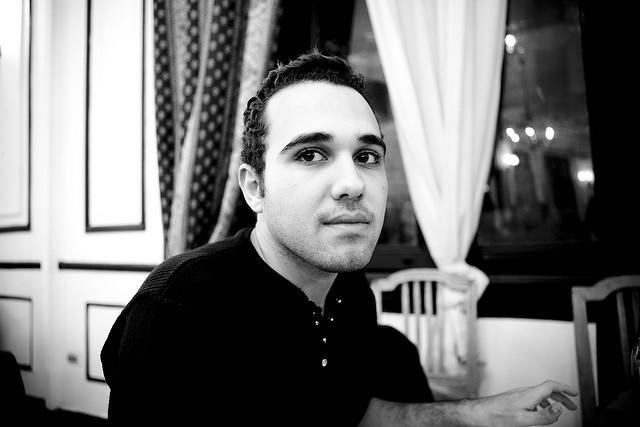
Rogers
By Ahmad Nagi
Dar Malamih lil-Nashr, 2007
Arabic
It’s not easy to talk about Rogers, Ahmad Nagi’s deliriously vexing new novel. It helps if you’ve read his excellent blog, in which the twenty-three-year-old writer limns his various obsessions, including psychedelic English rock bands, Japanese pop culture, Orientalist erotica, and Egyptian politics. Born in the 1980s, Nagi seems uniquely compelled by the decade that preceded him, which set the terms, if not the scene, for the phantasmagoric amalgamation that was Egyptian popular culture in the 1980s and 90s.
Rogers is the story of — see, it’s not actually the story of any one thing. But there is a narrator, at least, a child or boy who wants to escape, by any means necessary. For him, what that means is less an AK-47 than, say, an ancient bird of mythic provenance, or a mountain bike, or perhaps a giant robot of his own. With lyrical petulance, he whines to his mother, “Don’t I have a right to ride the roc and glide far from the war? Don’t I have a right to drive McFair and smash everything entangled, knotted, and painful, and not see it?” (The question of the correct verb to use when … using … a giant robot bedevils engineers and translators in any language, including Arabic.)
McFair is a “nuclear generator that works on perpetual energy, a hovercraft that works unplugged or connected to the electrical electronic brain.” This is not a bad description of Grendizer aka Grandizer aka Goldrake, the Japanese super-robot from the weekly anime series of the same name, which was broadcast across the Middle East in the 80s and 90s and dubbed into Arabic by Lebanese actors. McFair may elicit a smile from the reader’s lips, but, as in the passage above, the super-robot is often the object of the boy’s most existential fantasies, locus of his tears and pain.
There are fascists, too, evil fascists who are vanquished after a revolution that the narrator incites at his school. This rebellion is a spark that spreads to every quarter and street, creating an atmosphere that resembles that of the Lebanese civil war. There is something of Ziad Rahbani’s music here, and also the film version of Pink Floyd’s The Wall — the strong link between the implacable system of the revolution (its hierarchies and laws) and its madness (the killing, the wanton destruction and shedding of lustrous red blood). Among the multifarious texts Nagi evokes in Rogers, these two texts are the only ones that the writer takes completely seriously. In the preface to the novel, Nagi suggests that “to get the most pleasure out of this game, please listen to Pink Floyd’s The Wall while reading.” And one of the narrator’s friends is named Ziad — an homage to Rahbani, almost certainly, especially given some nearly word-for-word excerpts from The Mind Is an Ornament.
Myths also battle one another in the novel. The street on which the narrator lives is The Dragon That Was Eaten by the Sun Street, so named because the narrator’s uncle once vanquished a dragon on it, thereby humiliating the sun, which was left with no alternative but to go one better and burn the dragon up in the street, so as to win the approval of God the Almighty. Shortly before the end of the book, the narrator learns that the street has been renamed Abu Bakr al-Siddiq Street, in reference to the mosque that a professor from Dar al-Ulum has founded on it, a mosque that houses a piece of that venerable companion of the prophet’s clothing, as well as his sword. Thus one myth is replaced by another, a myth fashioned by the writer with one fashioned by society. In light of the neutral tone used by the narrator to tell his story, both myths have the same value, the two of them forming no more than a fertile soil for intertwining narratives.
Authorial subtlety is one of the central qualities of this novel. The presentation of all stories without a deep engagement with any, contiguity rather than accumulation, a focus on the elegance of transition not from incident to incident but from one parodic performance to another — these are the novel’s characteristics. It’s a narrative roundelay, a pulp experiment in contemporary mythography. Or, in the words of the preface: “a game in which music mixes with hallucinations, memories, and illicit literary appropriations; and even though it is not to be expected that all readers will find it an easy game to play, my hope is that it will be as enjoyable as eating pasta, which I personally like to eat with ground meat, which, as everyone knows, comes from cows, and cows, as we know, in winter, and with the right wind, can fly. We ask, therefore, of the High, the Almighty, that He make us one of those of His slaves who are a benefit to the Muslim nation, and now I’ve said my say, the game’s afoot, we’re on our way.”